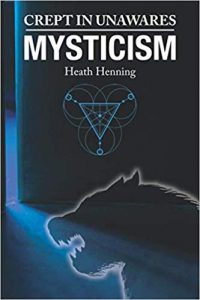[Excerpts from Crept In Unawares: Mysticism by Heath Henning is available for purchase here.]
The ancient antichrist apostasy has appeared again. J. Dwight Pentecost draws insight from John’s use of the word “antichrist.” “The emphasis is not on the future revelation of an individual, but rather on the present manifestation of false doctrine. To John [sic] antichrist was already present. The question arises then as to the relation between the ‘antichrist’ of John’s epistles and the beast of Revelation.”1)J. Dwight Pentecost, Things To Come: A Study In Biblical Eschatology,Zondervan,1958, 1978, p. 337 Pentecost did not deny the person known as the antichrist, but acknowledged that John’s emphasis was on the present antichrist doctrine. “The Apostle John employs the expression five times in his epistles. The first use of the term is to designate this eschatological personage in his qualities as an opposer of Christ.”2)Herman A. Hoyt, The End Times, BHM Books, 2006, p. 117
The multitude of opinions pivoting this mystery is due to the ignorance of history and hermeneutics. Gordon Fee and Douglas Stuart referred to this interpretive difficulty, saying,
In this regard the New Testament itself exhibits a certain amount of ambiguity. The antichrist figure, for example, is a particular difficult one. In Paul’s writings (2 Thess. 2:3-4) he is a definite figure; in Revelation 13-14 he comes in the form of the Roman emperor. In both cases, his appearance seems to be eschatological. Yet in 1 John, all of this is reinterpreted in a generalized way to refer to the so-called gnostics who were invading the church. How are we to understand this figure with regard to our own future?3)Gordon Fee & Douglas Stuart, How to Read the Bible for All Its Worth, Zondervan, 1981, 1993, p. 244
To accurately identify the beast of Revelation we must explore the relation to the antichrist doctrine John spoke of.
What is meant by John when speaking of “the spirit of antichrist” (1 John 4:3)? When applying proper hermeneutics to understand John’s exact meaning of this phrase “antichrist,” we should interpret it within the historical intent of the author’s purposed meaning. “John applies the term primarily to those who deny that Jesus is the Christ…. [In 1 John 2:22] he tries to combat the heresy of former believers who now deny the incarnation or the heterodoxy of Cerinthus who taught that Christ descended on the man Jesus only for a time.”4)Tim Dowley, John H.Y. Briggs, David F. Wright, Robert D. Linder. (ed.), Eerdman’s Handbook to the History of Christianity, WM. B. Eerdmans Publishing Co., 1977,p. 60 Cerinthus was an early Gnostic which shows that John applied the word “antichrist” to a Gnostic heretic.
Understanding John’s reference to the “antichrist” continued to be identified as Gnostics for centuries by various Christian authors. John’s disciple Polycarp (A.D. 69-156) is said to have confronted the Gnostic Marcion, calling him “the first born of Satan.”5)Irenaeus, Against Heresies, book III, III:4; The Ante-Nicene Fathers, ed. Alexander Roberts and James Donaldson; 1885-1887, Hendrickson, 1994, Vol. 1, p. 416 Polycarp’s disciple Irenaeus (A.D. 130-200), who produced the first thorough documentation against Gnosticism, “suggests that Marcion believed the serpent possessed him.”6)Peter Jones, The Gnostic Empire Strikes Back: An Old Heresy for the New Age, Presbyterian and Reformed Publishing Company, 1992, p. 36 Irenaeus also names Marcus, a specific leader of one sect “as if he really were the precursor of Antichrist.”7) Irenaeus, Against Heresies, book I, XIII:1; The Ante-Nicene Fathers, ed. Alexander Roberts and James Donaldson; 1885-1887, Hendrickson, 1994, Vol. 1, p. 334 Tertullian (A.D. 160-230) in his five books Against Marcion considered him “Antichrist”8)Tertullian, Against Marcion, chap. XXII; The Ante-Nicene Fathers, ed. Alexander Roberts and James Donaldson; 1885-1887, Hendrickson, 1994, Vol. 3, p. 287 and his followers, the “Marcionites, whom the Apostle John designated as antichrists.”9)Tertullian, Against Marcion, chap. XXII; The Ante-Nicene Fathers, ed. Alexander Roberts and James Donaldson; 1885-1887, Hendrickson, 1994, Vol. 3, p. 327
The Bible expositor John Gill (1691-1771) commenting on the phrase “even now there are many antichrists” (1 John 2:18), indicated it referred to Gnosticism and wrote a list of various Gnostic sects naming “the followers of Simon Magus, the Menandrians, Saturnilians, Basilidians, Nicolaites, Gnostics, Carpocratians, Cerinthians, Ebionites, and Nazarenes, as reckoned up by Epiphanius.”10)John Gill, John Gill’s Exposition of the Whole Bible, -1 John 2:18- (New Testament published in 3 Volumes 1746-1748); accessible at http://www.studylight.org/commentaries/geb/1-john-2.html He accurately stated, “antichrist in the former clause is explained by antichrists in this,”11)John Gill, John Gill’s Exposition of the Whole Bible, -1 John 2:18- (New Testament published in 3 Volumes 1746-1748); accessible at http://www.studylight.org/commentaries/geb/1-john-2.html meaning that the only accurate way to interpret the singular future tense “antichrist” by the terms relation to the plural present tense meaning. In fact, it would follow the logical fallacy of equivocation (applying different definitions to the same word within immediate context) if the antichrist to come is anything other than a Gnostic. This is the only consistent conclusion when using a strict grammatical-historical interpretation.
David Cloud says that 2 Timothy 3:13 “teaches that this apostasy, which began in the days of the apostles will grow in intensity as the church age progresses.”12)David Cloud, An Unshakable Faith: A Christian Apologetic Course, Way Of Life Literature, 2011, p. 47 The Scripture speaks of the “end times” as present tense during the apostolic age (1 John 2:18; Hebrew 1:2; 1 Peter 1:20), so the end time apostasy (2 Thessalonians 2:3) will be the same apostasy that the apostles contended against. Phil Arms explained, “Hence, apostate Christianity, not atheism, will be the ultimate New World Order’s last religion.” (Emphasis in original)13)Phil Arms, Promise Keepers: Another Trojan Horse, Shiloh Publishers, 1997, p. 78 The ancient antichrist apostasy will be identified as a system of paganism masquerading as Christianity, infiltrating churches. This paganized Christianity is what has been known historically as Gnosticism.
….
Surely, this was how the early Church fathers viewed Gnosticism in the second century. Irenaeus considered the Gnostics to be inspired by apostasy, demons, and idolatry, as the “predecessors of that dragon.”14)Irenaeus, Against Heresies, book II, XXXI:3; The Ante-Nicene Fathers, ed. Alexander Roberts and James Donaldson; 1885-1887, Hendrickson, 1994, Vol. 1, p. 407-408 This is because Gnosticism truly had no root within Christianity itself. Josh McDowell noted, “With Christianity exploding onto the scene of the Roman Empire, it is evident that other religions adopted certain teachings or practices from Christianity in order to stem the tide of departing adherents or, perhaps, to attract Christians to their side.”15)Josh McDowell, The DaVinci Code: A Quest for Answers, Green Key Books, 2006, p. 38
The Gnostics were not, as commonly believed, the first Christian heresy, rather preceding Christianity it saw the opportunity to further its ranks by simulating a Christian tone through adopting terms and phrases synthesized to their preexisting tenets. This was the first conspiracy to infiltration the churches as Jude spoke of. “It is now agreed that gnosis is an earlier phenomenon than the gospel. Gnostical theories were widely prevalent before Christianity.”16)Rev. F.W. Bussell, D.D., Religious Thought and Heresy in the Middle Ages, Robert Scott Roxburhge House Paternoster Row, E.C., 1918, p. 573
Debate has raged in the past of “pre-Christian Gnosticism” which was widely due to the broad scope of definitions for the term “Gnosticism” proposed by various scholars. The German higher criticism theologians, such as Rudolf Bultmann, postulated Gnosticism was pagan development which Christianity drew from. Peter Jones identified Bultmann’s “approach dismantles the theistic understanding of the New Testament in favor of a monistic, paganizing Gnostic one.”17)Peter Jones, Pagans in the Pews, Regal Books, 2001, p. 77 Professor Edwin Yamauchi reports, “As both Rudolph and Bianchi have noted, Gnosticism always appears as a parasite. ‘Nowhere do we find a pure form of Gnosticism, always it is built on earlier, pre-existing religions or on their traditions.’”18)Edwin Yamauchi, Pre-Christian Gnosticism: A Survey Of The Proposed Evidences, WM. B. Eerdmans Publishing Company, 1973, p. 185; citing H. J. W. Drijvers, “The Origins of Gnosticism as a Religious and Historical Problem”, Nederlands Theologisch Tijdschrift 22 (1968), p. 331 Albert Dagger insinuated, “During the Church’s early years, the Gnostics blended the ancient pagan mystery teachings with Christian teachings, thus devising esoteric interpretations of the Scriptures that remain with us today.”19)Albert James Dager, Vengeance Is Ours: The Church In Dominion, Sword Publishers, 1990, p. 11-12 Charles Ryrie explained “its main elements were Greek and Oriental; Jewish and Christian features were added to the mixture.”20)Charles C. Ryrie, The New Testament and Wycliffe Bible Commentary, The Iversen-Norman Associates, 1971, p. 1003 A correct view of Gnosticism would be the pagan mystery religions utilizing Christianity to develop a full religious system.
[Excerpts from Crept In Unawares: Mysticism by Heath Henning is available for purchase here.]
References


